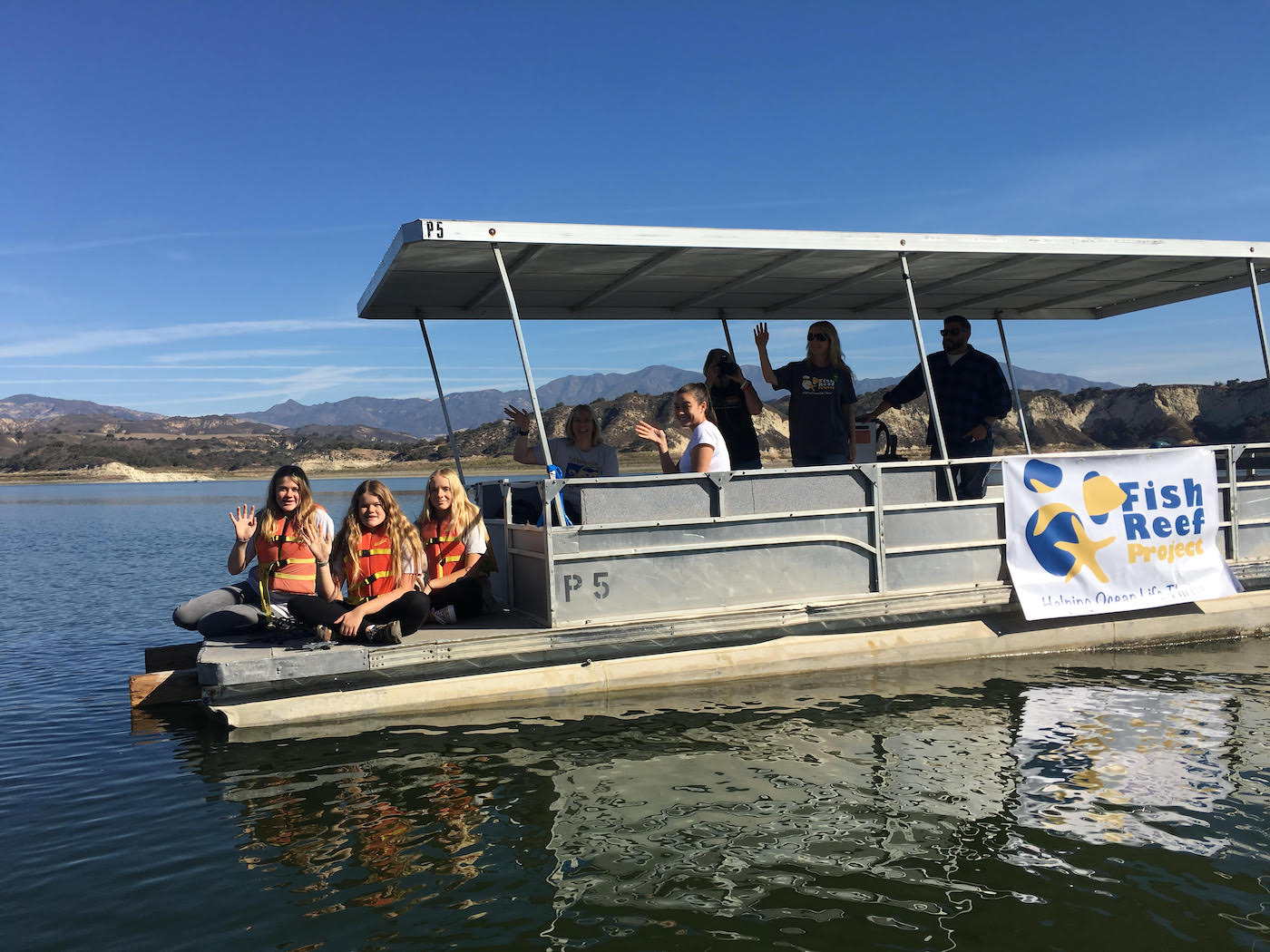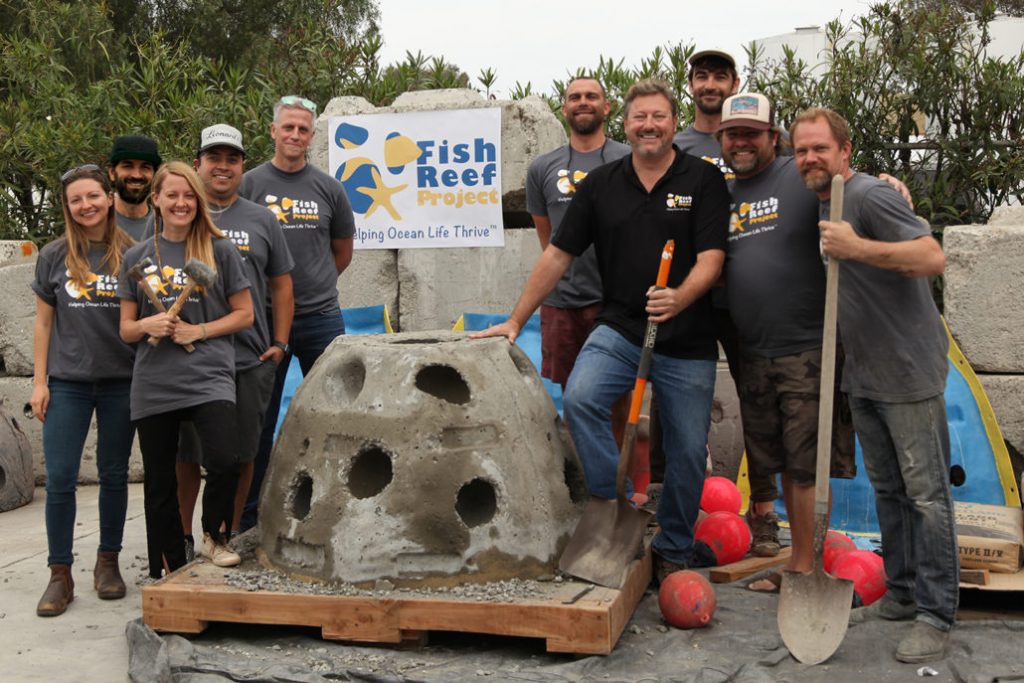Reef Restoration

Last October, aqua-hero and CEO of the Fish Reef Project Chris Goldblatt, with members of the team, invited a handful of journalists on a donated pontoon boat to watch the implementation of an artificial reef set in the shallow waters of Lake Cachuma.
The Fish Reef Project strives to show that artificial reefs – a barrier and safe habitat where fish can live, spawn, even hide from predators – will increase the population of fish and even wildlife at Lake Cachuma. This method of marine restoration has worked in the oceans around the world.
However, this is just a small demonstration of what the dedicated free-diver, scientist, and novelist, (and one of the early founders of the sustainable seafood movement), and the Fish Reef Project – who care deeply about the condition of our oceans’ habitat – can do for Goleta’s kelp beds; because as of right now there are none.
Chris studies the ocean regularly, donating 40-hours a week to the restoration of the Goleta kelp bed efforts.
Chris has watched the kelp and the reefs at Isla Vista and Goleta Beach melt into nothing since 1973. Now, at the beginning of 2019, Goleta’s shoreline is naked of kelp; the fish either moved away from the coastline and headed out to sea or… well, nobody can solidify that presumption.
Either way, chairman of the Santa Barbara County Fish and Game Commission, Phil Beguhl, says the restoration of the Goleta kelp bed is the “most significant environmental restoration effort made in the California marine environment in our lifetime.”
Commissioner Beguhl says the kelp beds suffered severe consequences when El Niño hit in 1983. The storm barreled through Santa Barbara County and the California land and sea and caused erosion to the protective kelp bed of Goleta, changing the beaches to barren and kelpless waters.
To add, Chris says the storms that cause innate landslides – and carry the giant boulders that, quite unfortunately, level our homes and worse – are supposed to land in the ocean, creating the natural reef and habitats for marine wildlife. This means that we as a coastal population, inadvertently or not, deprive our ocean of its necessities and the cultivation of its natural kelp beds.
“Reefs equal kelp,” says Chris, and we have prevented the natural resource for the cultivation of reefs and kelp beds with houses and our habitual way of life.
According to The Week, one-fourth of the ocean’s fish live and spawn in coral reefs; but worldwide, reefs show a 40 percent declination overall. The yellowfin-tuna, swordfish, and other large fish we commonly eat have dwindled by 90 percent. And “if mankind does not dramatically change how it treats the ocean… many marine species will become extinct” (theweek.com).
Chris knows he cannot save the entire ocean or scrutinize every bit of it, but he says “those are old numbers.” He is also wary of the word “extinct” when it comes to the ocean. “To say ‘extinct’ is pretty heavy”; there are 700,000 artificial reefs in the world, and 25 of them are here in California off Catalina Island, says the author of a six-part novel series called the Luke Dodge Sea Adventure series.
Fishin’ on the Coral Sea
It is easy to believe the captain of a fishing boat when you are out on the ocean enjoying what Ernest Hemingway lived for, and what most of us have enjoyed at one time or another. Moreover, being a captain or skipper of anything is quite commendable, indeed.
So on a one-day fishing trip back in December 2017 – back when the flames of the Thomas Fire crept along the foothills of Montecito and just before the horrific mudslide –the skipper of the Coral Sea’s analysis of the ocean and its current condition was certainly credible.
“Every year it gets better, the ocean is so alive,” the skipper said as we floated 23 miles offshore, stopping just in front of Santa Rosa Island where the rockfish and lingcod dwell in 300 feet of water.

Despite the habitat displayed on a tiny little screen of blurry colors – colors that often, and quickly, faded to black – the fishermen, some who traveled up to five hours to fish on this particular Santa Barbara boat, caught over 200 rockfish and lingcod that day – 81 the first hour off Santa Rosa Island, 23 miles off the coast of the American Riviera.
“This is a slow day,” the skipper said, who said the largest fish he ever caught was a 70-pound bluefin tuna out of Mexico waters. “We were pulling out fish like it was nothing.” The young skipper frequently peaked at the monitor that day last December. And when he would find the fish, he’d say, “drop ’em boys!” And they did. And quite successfully too.
The Purpose of the Reef
The main project is the restoration of the Goleta kelp beds, says Chris. The project requires $10 million to complete, but will restore the fishing and wildlife in the Goleta and Santa Barbara area. But that’s only for starters: the fish and wildlife will spread to other bodies of water and bring more of what we’ve missed for years. And without even realizing.
Chris and the Reef Project believe that the money for the building of the Goleta kelp beds will restore what he and the locals used to enjoy in their vibrant youth. Goleta kelp beds will make Santa Barbara waters flourish to the authentic fluorescence it is capable of, from shore to land. Also, the more protein we create and pull from the ocean, the less we use on the land and its habitat, says the marine expert.
The Fish Reef Project and Chris – who received a bachelor of science at Humboldt State – create artificial reefs for the benefit of the ecosystem, and are not out to prove anybody wrong. The Fish Reef Project has no quarrels with fishers or any organization with good intentions. Chris wants unity on and in the ocean as well as on land, especially when it comes to restoring our ecosystem.
The Old Man and the Sea
Since the fishermen seem to be happy, it could be that the 25 artificial reefs off of Catalina, among the 700,000 artificial reefs in the 70 countries around the world, are productive… right? Or maybe the Marine Mammal Protection Act enacted in 1972? Or the new fishing law of 1992, the High Seas Driftnet Fisheries Enforcement Act?
Local fisherman, Chuck Arreallanas, 72, rolled up his gear in ’92 when the new fishing laws made it next to impossible to fish or net within what Chuck says was four miles from shore. Chuck’s boat and gear simply could not and would not handle deep waters like the Coral Sea or other commercial boats.
Chuck ran to the tackle store after watching Spencer Tracy fight the biggest fish of his life at the Arlington Theatre in 1958 during the film, The Old Man and the Sea. But 1992 was the end of Chuck’s (over three-decade) run, living off white sea bass and halibut, the fat of the land and sea. When the retired fisherman was told of the kelp beds of Goleta, and how they are completely gone, the lifetime Santa Barbaran was slightly shocked.
However, activists and committed ocean scientists like Chris have spent the last 30 years working to restore the beauty of the ocean’s habitat in Goleta – a stretch of the ocean he enjoyed in the prime of his childhood and early adolescence. Chris’s motive in no way carries the intentions of bothering the fishermen. (Chris is confident that the fishermen will not be upset about the cultivation of artificial reefs which will provide more fish for them and everyone on and offshore. Not one single bit).
And the Reef Will be Named…
This part makes one’s imagination wander (and it is one of the only times in my life where I wished I had a pile of money). The section of the reef which the donor buys for the Goleta kelp bed project will be named after that person.
However, the name of the reef does not have to be purchased by more than one person. For example, let’s say Penguin Publishing gives Jon Vreeland a $10-million-dollar advance in a contract, and Mr. Vreeland takes that tax-deductible 10-million and donates all the money to the Fish Reef Project, Vreeland has then funded the entire Goleta Kelp Forest Restoration project in one single donation.
Now every time the writer gazes out off the beach in Goleta and Isla Vista, or every time he watches the ocean shimmer and dance while driving down the 154 or 101 freeway, he can say: “Look, there’s Vreeland’s Reef. There’s his immortal contribution to planet Earth. There’s his gift to his family and all of yours, and all the generations to come. There is his ultimate Magnum Opus.”





